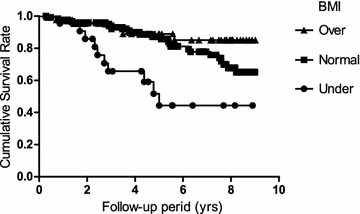Underweight body mass index is a risk factor of mortality in outpatients with nocturia in Japan
- PMID: 26415511
- PMCID: PMC4587784
- DOI: 10.1186/s13104-015-1456-6
Underweight body mass index is a risk factor of mortality in outpatients with nocturia in Japan
Abstract
Background: Although nocturia has been reported to increase mortality in elderly individuals, the particular risk factors that are associated with this event are unclear. Therefore, we evaluated risk factors for death in outpatients with nocturia.
Methods: Between October 2002 and December 2009, 250 consecutive patients with nocturia were enrolled in two general hospitals in Japan. Among them, 193 patients were able to be followed for at least 1 year and up to 9 years (median 4.8 years) if the patients did not die. Mortality rates and risk factors were evaluated in the nocturic outpatients.
Results: Two- and 5-year survival of the nocturic outpatients was 94.6% [95% confidence interval (CI) = 92.2-97.1] and 82.6% (95% CI = 75.4-87.8), respectively. Higher Charlson Comorbidity Score, lower body mass index (BMI) and lower Physical Component Summary of Short Form-36 item scores were significantly correlated with mortality (p < 0.0001, p < 0.005 and p < 0.05, respectively) in multivariate analysis. The International Prostate Symptom Score, Pittsburgh Sleep Quality Index, Mental or Role/Social Component Summary of Short Form-36 item scores and Nocturnal Polyuria index were not significantly correlated with mortality. The mortality rate was significantly higher in subjects with an underweight BMI (<18.50) compared with a normal range (18.50-24.99) or overweight (≥25.00) BMI [p < 0.00005, hazard ratio (HR) = 5.84, 95% CI = 2.03-16.8; p < 0.0005, HR = 5.92, 95% CI = 1.94-18.0].
Conclusions: Additional attention is required for nocturic outpatients with not only a high Charlson Comorbidity Score but also an underweight BMI because of their high mortality. Large prospective studies are warranted to validate this finding and extend more.
Figures
Comment in
-
Re: Underweight Body Mass Index is a Risk Factor of Mortality in Outpatients with Nocturia in Japan.J Urol. 2016 May;195(5):1543-1544. doi: 10.1016/j.juro.2016.02.039. Epub 2016 Feb 13. J Urol. 2016. PMID: 27186756 No abstract available.
Similar articles
-
Complex relationship of body mass index with mortality in patients with critical limb ischemia undergoing endovascular treatment.Eur J Vasc Endovasc Surg. 2015 Mar;49(3):297-305. doi: 10.1016/j.ejvs.2014.10.014. Epub 2014 Dec 15. Eur J Vasc Endovasc Surg. 2015. PMID: 25524520
-
Low, rather than high, body mass index confers increased risk for post-liver transplant death and graft loss: Risk modulated by model for end-stage liver disease.Liver Transpl. 2015 Oct;21(10):1286-94. doi: 10.1002/lt.24188. Liver Transpl. 2015. PMID: 26097202
-
Re: Underweight Body Mass Index is a Risk Factor of Mortality in Outpatients with Nocturia in Japan.J Urol. 2016 May;195(5):1543-1544. doi: 10.1016/j.juro.2016.02.039. Epub 2016 Feb 13. J Urol. 2016. PMID: 27186756 No abstract available.
-
Inverse relationship between body mass index and mortality in older nursing home residents: a meta-analysis of 19,538 elderly subjects.Obes Rev. 2015 Nov;16(11):1001-15. doi: 10.1111/obr.12309. Epub 2015 Aug 7. Obes Rev. 2015. PMID: 26252230 Review.
-
The Impact of Nocturia on Mortality: A Systematic Review and Meta-Analysis.J Urol. 2020 Mar;203(3):486-495. doi: 10.1097/JU.0000000000000463. Epub 2019 Jul 31. J Urol. 2020. PMID: 31364920
Cited by
-
Analysis of the Prevalence and Factors Associated with Nocturia in Adult Korean Men.Sci Rep. 2017 Jan 31;7:41714. doi: 10.1038/srep41714. Sci Rep. 2017. PMID: 28139743 Free PMC article.
-
Correlates of the double burden of malnutrition among women: an analysis of cross sectional survey data from sub-Saharan Africa.BMJ Open. 2019 Jul 3;9(7):e029545. doi: 10.1136/bmjopen-2019-029545. BMJ Open. 2019. PMID: 31272983 Free PMC article.
-
Double burden of malnutrition among women of reproductive age in Bangladesh: A comparative study of classical and Bayesian logistic regression approach.Food Sci Nutr. 2023 Jan 6;11(4):1785-1796. doi: 10.1002/fsn3.3209. eCollection 2023 Apr. Food Sci Nutr. 2023. PMID: 37051361 Free PMC article.
References
MeSH terms
LinkOut - more resources
Full Text Sources
Other Literature Sources


